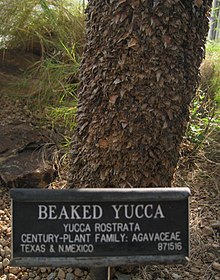| Beaked yucca | |
|---|---|

| |
| Yucca rostrata | |
|
Scientific classification
| |
| Kingdom: | Plantae |
| Clade: | Tracheophytes |
| Clade: | Angiosperms |
| Clade: | Monocots |
| Order: | Asparagales |
| Family: | Asparagaceae |
| Subfamily: | Agavoideae |
| Genus: | Yucca |
| Species: | Y. rostrata
|
| Binomial name | |
| Yucca rostrata | |

| |
| Synonyms [2] | |
| |
Yucca rostrata [3] also called beaked yucca, is a tree-like plant belonging to the genus Yucca. The species is native to Texas, and the Chihuahua and Coahuila regions of Mexico. This species of Yucca occurs in areas that are arid with little annual rainfall. [4] [5]
Yucca rostrata has a trunk up to 4.5 meters tall, with a crown of leaves at the top. Leaves are thin, stiff, up to 60 cm long but rarely more than 15 mm wide, tapering to a sharp point at the tip. The inflorescence is a large panicle 100 cm tall, with white flowers. [4] [5] [6]
Cultivation

As one of the hardiest trunk-forming yuccas, Yucca rostrata can be grown successfully outdoors down to USDA hardiness zone 5 and is popular in many desert cities such as Palm Springs, CA, Phoenix, AZ, and Las Vegas, NV, in the Southwestern United States. The tree-like plant is also commonly cultivated in garden zones 7 and 8 in El Paso, Texas, Albuquerque, New Mexico, Salt Lake City, Utah, and Denver, Colorado. [7] [8] [9] More recently, Yucca rostrata is being used in beach landscaping in coastal zone 7 and 8 areas of the East Coast, and can be found in coastal North Carolina, Virginia Beach, VA, Ocean City, MD, and on Long Island, NY and coastal Connecticut.
In Southern Europe, Yucca rostrata is cultivated in the subtropical Mediterranean region, including in southern Italy, Spain, Greece, and southern France. Rostrata is also cultivated in smaller numbers north into temperate Europe in the UK, Germany, and other areas. In these latter areas, cultivation is often more difficult in the cool summers and wet climates found in these areas. However, many people in the cooler and wetter parts of Northwest Europe cover Yucca rostrata in winter to keep moisture off the plant. Yucca rostrata is also popular in Australia and is on occasion used as a specimen plant in home landscapes.

Cultivars
References
- ^ Ayala-Hernández, M.M.; Solano, E.; Puente, R.; Clary, K. (2020). "Yucca rostrata". IUCN Red List of Threatened Species. 2020: e.T117428481A117470177. doi: 10.2305/IUCN.UK.2020-2.RLTS.T117428481A117470177.en. Retrieved 19 November 2021.
- ^ The Plant List Yucca rostrata
- ^ Trelease, Annual Report of the Missouri Botanical Garden 13: 68, plates 40–42, plate 84, fig. 3, plate 93, fig. 2. 1902.
- ^ a b "Botanica. The Illustrated AZ of over 10000 garden plants and how to cultivate them", p 941. Könemann, 2004. ISBN 3-8331-1253-0
- ^ a b Trelease, William. 1902. Annual Report of the Missouri Botanical Garden 13: 68, plates 40–42, plate 84, fig. 3, plate 93, fig. 2. Yucca rostrata
- ^ Ferguson, David J. 1996. Cactus and Succulent Journal (U.S.) Los Angeles 68(3): 130, Yucca linearis
- ^ "Yuccalicious! Succulent delights at Denver Botanic Gardens' Yuccarama".
- ^ "Hardy Tropical Plants: Yucca rostrata". Archived from the original on 2015-04-11. Retrieved 2015-04-10.
- ^ "Forget 'cactus and gravel,' Red Butte's new Water Conservation Garden showcases beauty in the desert".
- ^ Plant Delights Nursery, The Woodlands Texas, Sapphire Skies for sale/
- ^ Mobnrovia Horticultural Craftsmen, Azusa California, Sapphire Skies Beaked Blue Yucca
- Fritz Hochstätter (Hrsg.): Yucca (Agavaceae). Band 1 Dehiscent-fruited species in the Southwest and Midwest of the USA, Canada and Baja California , Selbst Verlag, 2000. ISBN 3-00-005946-6
- Fritz Hochstätter (Hrsg.): Yucca (Agavaceae). Band 2 Indehiscent-fruited species in the Southwest, Midwest and East of the USA, Selbst Verlag. 2002. ISBN 3-00-009008-8
- Fritz Hochstätter (Hrsg.): Yucca (Agavaceae). Band 3 Mexico , Selbst Verlag, 2004. ISBN 3-00-013124-8
- Die Gattung Yucca Fritz Hochstätter
- Yucca I [1] Archived 2011-03-09 at the Wayback Machine Verbreitungskarte I Fritz Hochstätter
External links
- Yucca rostrata care
- Common names of yucca species
- Interactive Distribution Map of Yucca rostrata
- photo of herbarium specimen at Missouri Botanical Garden, type of Yucca rostrata
